Pharmacologic Management of Adult Cancer Pain
The intent of this article is to provide oncology nurses with practical information on the pharmacologic management of pain. The use of chemotherapy, radiation therapy, and surgery in pain management will not be addressed in this article. It is the second in a three-part series on cancer pain management. The first in the series (September 2006) addressed cancer pain assessment. In a future issue, the third in the series will address nonpharmacologic approaches to cancer pain management.
ABSTRACT: The intent of this article is to provide oncology nurses with practical information on the pharmacologic management of pain. The use of chemotherapy, radiation therapy, and surgery in pain management will not be addressed in this article. It is the second in a three-part series on cancer pain management. The first in the series (September 2006) addressed cancer pain assessment. In a future issue, the third in the series will address nonpharmacologic approaches to cancer pain management.
Over 2 decades ago, an expert committee, convened by the cancer unit of the World Health Organization (WHO), developed a three-step analgesic ladder approach to the selection of drugs for the treatment of cancer pain.[1] Three categories of analgesic drugs were included in the ladder: nonsteroidal anti-inflammatory drugs (NSAIDs), opioids, and adjuvant or coanalgesics. The principles behind this three-step analgesic ladder approach to the management of pain remains valid today. Patients were assigned to steps on the ladder based on self report of the severity of their painstep 1 for mild pain (rated as 1-4 on a 10-point scale) where the use of NSAIDs and adjuvants or coanalgesics are recommended; step 2 for moderate pain (rated 5-6 on a 10-point scale) where low dose opioids often in combination with acetaminophen as well as an adjuvant or co-analgesics are recommended; and step 3 for severe pain (rated at 7-10 on a 10-point scale) where strong opioids in addition to NSAIDs and adjuvants or coanalgesics are recommended. Also, inherent in this model is the principle that people with nearly continuous pain will need around-the-clock analgesics.

The following section will provide a basic overview of the agents used in the three-step analgesic ladder.
NSAIDs and Acetaminophen
The NSAIDs include many subclasses, are frequently used in all steps of the analgesic ladder, and are analgesic, antipyretic, and anti-inflammatory (Table 1). The NSAID drugs mainly affect analgesia by reducing the biosynthesis of prostaglandins, inhibiting the cascade of inflammatory events that contribute to nociception.[3]
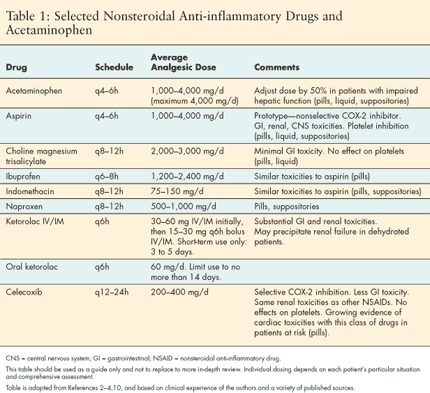
Aspirin is the prototype of the NSAIDs. Acetaminophen, although lacking in significant anti-inflammatory effects, and with a different side-effect profile, is often placed within this group. Nonsteroidal anti-inflammatory drugs are most effective in treating mild to moderate pain when there is an inflammatory component present. The NSAIDs can be extremely effective when combined with an opioid drug in treating bone pain in cancer patients (prostaglandins, which are rich in the periosteum of the bone, are implicated in pain modulation). Unlike the opioid drugs, the NSAIDs have a ceiling effect (a dose beyond which added analgesia is not obtained and side effects become more significant). These drugs do not produce tolerance or physical dependence, and are not associated with psychological dependence (addiction). This class of drugs may also have an opioid sparing effect in some patients.[4,5]
Adverse Effects
The potential adverse effects that can occur with the NSAIDs include those affecting the hematologic, gastrointestinal, renal, and central nervous systems.[4] The selective COX-2 inhibitors differ in their side-effect profile from other NSAIDs in relation to potential for less gastric irritation (at least with short-term use) and interference with platelet aggregation.[6,7] Renal adverse effects, however, are similar, and concern about cardiovascular risks suggests that they should always be used with caution in "at-risk" patients.[8,9]
Acetaminophen has fewer adverse effects than the NSAIDs. Gastrointestinal toxicity is rare, and there are no adverse effects on platelet function or cross-reactivity in patients with aspirin hypersensitivity.[2] Hepatic toxicity can occur, however, and patients with chronic alcoholism and liver disease can develop severe hepatotoxicity even when the drug is taken in usual therapeutic doses.[10] Guidelines for the selection and use of the NSAIDs and acetaminophen are seen in Table 2.
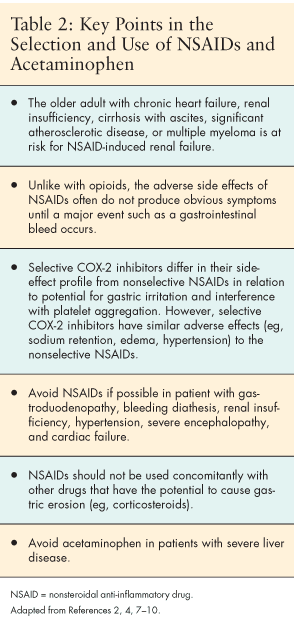
The Opioid Drugs
Opioid analgesics are the mainstay of cancer pain management. These drugs are used for moderate to severe pain in steps 2 and 3 of the analgesic ladder. Dose escalation is governed by the balance between pain relief and intolerable and unmanageable side effects. However, both clinician and patient/family concerns about the addictive properties of this class of drugs also affects how these drugs are prescribed and taken. These concerns can lead to undertreatment. It is extremely important that clinicians, patients, and families understand the difference and differentiate between addiction (psychological dependence), physical dependence, tolerance, and pseudoaddiction[11] (Table 3). The only absolute contraindication to the use of an opioid is a history of hypersensitivity reaction (rash, wheezing, edema). Allergic reactions are almost always limited to the morphine derivatives. In the rare event that a patient describes a true allergic reaction, one approach would be to begin therapy with a small dose of a short-acting synthetic opioid such as fentanyl. The dose can gradually be increased depending on the patient's response.[3]
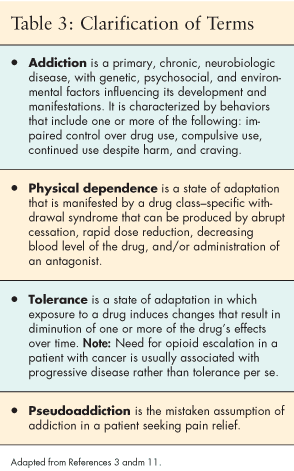
The opioids can be divided into the following categories: agonists, agonist-antagonists, and antagonists.[2] Pure opioid agonists, for example, morphine, hydromorphone, oxycodone, fentanyl, and methadone are the opioids most commonly used in the management of cancer-related pain and will be discussed in more detail in the sections below. Partial agonists, for example, butorphanol and pentazocine (Talwin), have limited use in cancer pain management. Their pharmacology is characterized by a ceiling effect to analgesia and the ability to precipitate withdrawal symptoms in patients who are physically dependent on pure agonist drugs. The incidence of psychotomimetic effects (including agitation, dysphoria, confusion) from the mixed agonist-antagonist is greater than that of pure agonists (morphine-like drugs).[12] The opioid antagonist drugs include naloxone and naltrexone. These drugs bind to opioid receptors and block the effect of morphine-like agonists.
Morphine
Morphine is the prototype opioid agonist. It is used as a measure for dose equivalence among the opioids (see Table 4). The WHO placed morphine on the essential drug list and requested that it be made available throughout the world for cancer pain relief.[1] In patients with normal renal function the average duration of analgesia is about 4 hours.[12] Morphine-3-glucoronide (M-3-G), which is an active metabolite of morphine, may contribute to signs of opioid toxicity including myoclonus, seizures, and hyperalgesia in patients who cannot clear the metabolite due to renal impairment.[2,13] Morphine is available in tablet, elixir, suppository, and parenteral form. Various long-acting formulations provide analgesia with duration from 8 to 12 to 24 hours.

Hydromorphone
Hydromorphone is a synthetic short half-life opioid that is a useful alternative to patients who tolerate morphine poorly. Hydromorphone is more potent than morphine (Table 4) and is available in tablet, elixir, suppository, and parenteral form. There is no controlled release formulation available in the United States. The half-life of hydromorphone of 1.5 to 3 hours is slightly shorter than that of morphine. Hydromorphone has an active metabolite hydromorphone-3-glucoronide (H-3-G). As with morphine, patients with impaired renal function are at risk to accumulate the active metabolite which may contribute to signs of opioid toxicity including myoclonus, seizures, and hyperalgesia.[13-15]
Oxycodone
Oxycodone, a synthetic opioid with a better oral absorption than that of morphine,[16] has a half-life of 2 to 4 hours and is mainly excreted by the kidneys. Oxycodone is available in combination with aspirin or acetaminophen or as a single agent in an immediate-release or a controlled release form. The controlled-release form provides the patient with analgesia for 8 to 12 hours. Oxycodone is used in steps 2 and 3 of the analgesic ladder. It is not available in parenteral from.
Fentanyl
Fentanyl is a potent short half-life opioid that is being used with increasing frequency in palliative care. Because of its potency dosing is usually in micrograms. Fentanyl comes in a transdermal, transmucosal, and parenteral form. In the transmucosal, buccal, and parenteral form it has a rapid onset of action and short duration of effect.
• Transdermal FentanylThe transdermal fentanyl delivery system consists of a drug reservoir in the form of a patch that is separated from the skin by a copolymer membrane that controls the rate of drug delivery to the skin surface. Clinical experience with cancer patients suggest that a 100-µg fentanyl patch delivers the equianalgesic equivalent of 4 mg of parenteral morphine per hour (refer to Table 4). Transdermal fentanyl has only been approved for the management of chronic cancer pain. Although most patients maintain satisfactory pain control with a patch change every 72 hours, some patients require the patch to be changed after 48 hours. There is a lag time from patch placement to the patient feeling a substantial therapeutic effect (12 to 16 h) and approximately 48 hours to reach steady state blood concentrations.[12] Availability of a different route of drug administration is therefore necessary during the 12 to 16 hours following the initial patch placement. An alternate route of drug administration is also required for breakthrough pain medication. Significant concentrations of fentanyl remain in the plasma for about 24 hours after removal of the patch because of delayed release from the tissues and subcutaneous depots. Drug side effects (if present) may persist for that length of time. Although the fentanyl patch can be used safely in older adults the frail elderly who have multiple adverse effects from a variety of opioids may not do well with this route of administration. Fever, cachexia, obesity, and ascites may all have a significant effects on absorption predicability of blood levels and clinical effects.[17]
• Oral Transmucosal Fentanyl Citrate (OTFC)Recommended only to be used in patients who are opioid tolerant, and who are receiving the equivalent of no less than 60 mg of oral morphine a day or transdermal fentanyl 50 µg every 3 days. Oral transmucosal fentanyl differs from other breakthrough pain medication in that there is little relationship between the baseline dose of the patient's pain medication, and the microgram dose of OTFC required to relieve breakthrough pain.[2] In all other opioid drugs there is a relation between the two. With OTFC the smallest available dose is initially chosen (200 µg) and titrated up depending on the patient's response (available strengths range from 200 to 1,600 µg per unit).[18]
• Fentanyl Effervescent Buccal Tablet (FEBT)An enhanced buccal delivery system for fentanyl using an effervescent buccal tablet (FEBT) has recently become available. The currently available fentanyl buccal tablet is sugar-free (an advantage because of reports of tooth decay possibly associated with the sugar content found in OTFC) and is placed between the upper cheek and gum above a rear molar tooth. It is available in five dosage strengths: 100/200/400/600/800 µg. Due to its higher bioavailability than OTFC it cannot be substituted on a microgram per microgram basis. Therapeutic benefit can be achieved at a lower dose.[19]
Methadone
Has unique properties that makes it a useful synthetic opioid in the management of severe chronic pain especially where there is a neuropathic component or the patient has not done well on the other opioid drugs. Methadone may bind to the N-methyl-D-aspartate (NMDA) receptor (implicated in neuropathic pain) where it has antagonistic activity as well as agonist activities at the mu opioid receptor sites. Methadone is mainly metabolized in the liver and can be safely used in patients with renal disease. An added benefit of methadone is that it is extremely inexpensive.[20,21]
But, methadone's long and variable half-life (range: 13 hours to over 100 hours), and the discrepancy between drug half life and the duration of analgesic effect (4 to 8 hours), make it a potentially dangerous drug to use in inexperienced hands. If titrated too rapidly patients are at increased risk for drug accumulation before reaching steady state and subsequent toxicity including sedation and respiratory depression. Careful titration and close monitoring is required. In addition methadone is primarily metabolized by CYP enzymes. Drugs that induce CYP enzymes, for example, dexamethasone, carbamazepine, phenytoin, and barbiturates, may accelerate the metabolism of methadone resulting in decreased plasma levels of the drug and decreased pain relief.
On the other hand drugs that inhibit CYP enzymes, for example, ketoconazole, omeprazole, and SSRI antidepressants, may potentially slow down the metabolism of methadone leading to sedation and the possibility of respiratory depression.[20-22] (Because of these factors, being aware of additions and subtractions to a patient's medication regimen is an important aspect of pain assessment and management.) Recent studies suggest parenteral methadone can result in QT wave prolongation and the possibility of torsade de pointes.[23-25] It is not clear if this is associated with the preservatives usually found in the parenteral formulation (parenteral methadone is available preservative-free form). Some institutional practice is to record and evaluate an initial EKG when starting a patient on parenteral methadone and whenever the dose is increased.
Despite all of these cautions methadone can be a very useful drug for cancer pain management. The risk of delayed toxicity from methadone accumulation can be reduced if the initial period of dosing is accomplished with "as needed" administration. When a steady state has been approached (2 to 5 days after starting treatment for most patients) a fixed dosing schedule of every 4 to 8 hours can be substituted. An opioid with a short half-life such as morphine, hydromorphone, or oxycodone is frequently used for supplementary or "rescue" dosing although methadone can also be used. When rotating a patient from morphine to methadone, the higher the 24-hour dose of morphine the patient has been receiving, the smaller the dose of methadone that is needed to provide pain relief[21,26] (see Table 5).
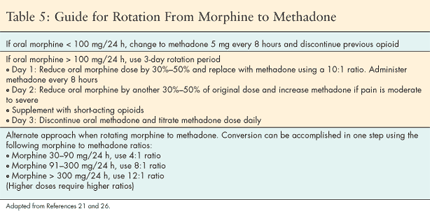
Selecting a Route and Dosing Interval
Although most patients do well on the oral route of drug administration for the management of their chronic pain, there are times when an alternate route of administration is required. The most commonly used alternate routes include rectal, sublingual, transmucosal, transdermal, subcutaneous, intravenous, epidural, and intrathecal. Patient controlled analgesia is fairly common in palliative care patients requiring a parenteral route of drug administration. This technique can be managed safely at home for most patients, if a system of education, monitoring, and support is in place.[27]
A switch in opioid or route of opioid administration requires knowledge of relative potencies among drugs and between routes to avoid overdosing or underdosing (Table 4). These times of transition, from one drug or route to another, place patients at risk for pain escalation, or the development of adverse effects. Frequent assessment is therefore required during the transition period. The equianalgesic dose table provides a guide to dose selection when these changes are made. The calculated equianalgesic dose is usually reduced 25% to 50% when switching drugs (unless pain was not well controlled on the previous opioid) to account for incomplete cross tolerance. A much larger reduction (sometimes as much as 80% to 90%) is necessary when switching to methadone to prevent oversedation (Table 5). Ongoing reassessments regarding the adequacy of pain relief and the presence of side effects are key.
Patients with continuous or frequently occurring pain generally benefit from scheduled around-the-clock (ATC) dosing. This provides a more stable plasma level of the drug and helps prevent pain from recurring. A "rescue" dose is offered on a prn basis and provides a means to treat pain that breaks through the fixed analgesic schedule. The drug used for breakthrough pain is usually the same as that administered on a regular basis. Clinical guidelines suggests that the rescue dose should be calculated as about 25 to 50% of the hourly dose, or 5 to 15% of the 24-hour baseline dose.[2,12,28,29] For example, a patient receiving 60 mg of a controlled-release oral morphine preparation every 12 hours should have a rescue or supplemental dose of 5 to 15 mg of immediate-release morphine available on a 2- to 3-hour basis. Patients who have more severe breakthrough or incident pain will usually have the larger (15%) rescue while individuals who are more sensitive to the bolus effects of the rescue may have the smaller (5%) dose rescue prescribed.
Choice of Starting Dose and Dose Titration
For acute, severe pain, a patient who is opioid-naive generally begins treatment at an opioid dose equivalent to 5 to 10 mg of parenteral morphine every 4 hours[2,29] (refer to Table 4). This is the equivalent of going straight to step 3 of the analgesic ladder and bypassing steps 1 and 2. For mild to moderate pain, however, drugs from step 1 or step 2 of the analgesic ladder may be selected. Titration of the opioid dose is usually necessary at the start of pain therapy and at different points during the disease course. At all times, inadequate relief should be addressed with dose escalation until relief is reported or until intolerable and unmanageable side effects occur (Table 6).
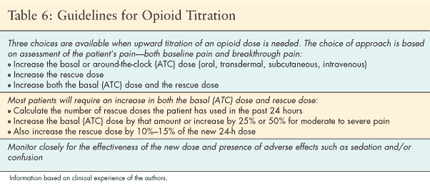
Integration of around-the-clock dosing with supplemental rescue doses provides a rational stepwise approach to dose escalation and is appropriate to all routes of drug administration. Patients who require more than four to six rescue doses per day should generally undergo escalation of the baseline dose. In most cases, escalation of the baseline dose should be accompanied by a proportional increase in the rescue dose so that the size of the supplemental dose remains a constant percentage of the fixed dose. Assessment of the patient's pattern of pain, rescue use, and level of pain relief is essential for appropriate dose titration. Table 7 summarizes the basic principles of using opioid drugs to manage pain.
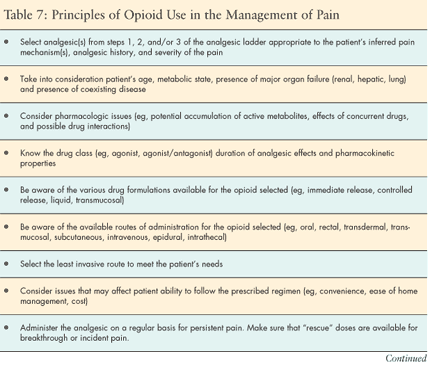

Opioid Side Effects
Inadequate management of distressing opioid-related side effects has a significant impact on a patient's overall quality of life and willingness to use this class of drugs in adequate amounts to control pain.[30] Although tolerance develops to most of opioid-related side effects, constipation is the exception.[12] In general, if a patient has one or two side effects and their pain control is good the approach is to treat the side effects and continue on the same opioid. However when two or more distressing side effects are present (excluding constipation) opioid rotation is warranted (refer to Table 8).

Constipation
Constipation is the most frequently encountered opioid related side effect and the one to which patients rarely develop tolerance.[30] Opioid binding to peripheral receptors in the gut prolongs colon transit time by increasing or decreasing segmental contractions and decreasing propulsive peristalsis. Because the likelihood of constipation is so great in patients who are receiving opioid therapy laxatives should be prescribed in a preemptive manner.[12]
Sedation
Some level of sedation is experienced by many patients at the initiation of opioid therapy and during significant dose escalation. Patients usually develop tolerance to this effect in days to weeks.[12,30] Should sedation persist at a level that is unacceptable to the patient other confounding factors should be explored. These include other sedating drugs, metabolic disturbances and sleep deprivation. Management includes elimination of non essential sedating drugs, reduction of the opioid dose if feasible or giving a smaller dose at more frequent time intervals, rotating to a different opioid drug, and if necessary adding a psychostimulant such as modafinil (Provigil) or methylphenidate.[31]
Mental "Haziness" or Mild Cognitive Impairment
Like sedation, mild cognitive impairment is not uncommon after initiation of opioid therapy. Patients may express this as not feeling "as sharp" as before. These effects are transient in most patients and last for a few days. Persistent confusion attributable to opioids alone is uncommon.
Nausea and Vomiting
Nausea at the start of opioid therapy may occur.[12] Tolerance to this effect usually occurs within days to weeks. Both peripheral and central mechanisms are thought to be involved. Constipation may also be a contributing factor. Establishing the pattern of the nausea may help clarify the etiology of subsequent treatment. A combination of pharmacotherapy and cognitive approaches can be used. Scheduled around-the-clock antiemetics for 48 hours or so with a gradual change back to as needed dosing may be useful to some patients. Occasionally a change in opioid (opioid rotation) is necessary.
Multifocal Myoclonus
Mild and infrequent myoclonus can occur with all opioids.[12,32] The effect is usually dose related and the mechanism is unclear. Pronounced myoclonus is extremely distressing to the patient and can cause or exacerbate pain. Myoclonus can be a sign of opioid toxicity and can be a reason for opioid rotation. A benzodiazepine can be used to treat the symptom.
Urinary Retention
Urinary retention can occur in patients on opioid therapy especially in a setting of rapid dose escalation.[12] Added risk factors include the patient who is receiving other drugs with anticholinergic effects, for example tricyclic antidepressants, or who has an already compromised bladder. Older men with an enlarged prostate are especially at risk.
Pruritus
Pruritus can occur with any opioid and is associated with histamine release. It is most commonly seen with morphine use. Fentanyl and oxymorphone may be associated with less histamine release.[2] Antihistamines are often the first line approach to this symptom if it is troublesome to the patient. Ondansetron (Zofran) has been reported to relieve opioid-induced pruritus.[33]
Respiratory Depression
Clinically significant respiratory depression is almost always accompanied by other signs of central nervous system depression such as sedation. Its occurrence is unusual in a patient on chronic opioid therapy unless other contributing factors are present. With repeated administration of an opioid, tolerance develops to the respiratory depressant effects of the drug. Unwarranted fear of respiratory depression should not interfere with appropriate upward titration of opioid drugs to relieve pain.[2]
Adjuvant or Coanalgesic Analgesia
Adjuvant analgesics are those drugs that have a primary indication other than pain but are analgesic in certain pain states.[34] These drugs can be used at any step of the "analgesic ladder." As with the institution of any analgesic regimen their use is based on a careful assessment of the pain, inferred pain mechanism(s), and analgesic history. Adjuvant drugs in the palliative care setting are typically used to enhance the effects of the opioid drugs, or to allow for dose reduction because of adverse opioid side effects.[34] Table 9 provides a guide to the commonly used adjuvant drugs. As a general principle low initial doses with dose titration until symptom relief is achieved is suggested.

Multipurpose Adjuvant Analgesics
• CorticosteroidsCorticosteroids are used to treat various types of neuropathic pain resulting from tumor infiltrating or compressing neural structures such as nerve, plexus, root, or spinal cord.[35,36] Corticosteroids can be extremely useful in the acute management of a pain crisis when neural structures or bone are involved.[35,36] Dexamethasone (16-24 mg/d), in combination with an opioid, may be used to treat bone pain, neuropathic pain, back pain associated with cord compression, headaches associated with brain tumors, and pain associated with liver capsule distension. Pain relief is assumed to be associated with anti-inflammatory and antiedema effects.[35] Adverse effects of corticosteroids include hyperglycemia, gastric irritation, dysphoria, delirium, and myopathy. Lower-dose corticosteroids (2 to 4 mg dexamethasone) can improve mood and appetite. These drugs should not be used concurrently with a NSAID and their use should be combined with gastroprotective therapy. Be aware that a patient who is on steroids for reasons other than pain, may experience increased pain or analgesic requirements if these steroids are tapered down.
• Antidepressant DrugsAntidepressant drugs are nonspecific analgesics that are used predominantly for the continuous dysesthesias component of neuropathic pain in the cancer population. Analgesia can occur in the absence of mood change, and the effective analgesic dose in the palliative care population is usually lower than that required to treat depression.[34] Their analgesic effect appears to be related to inhibition of norepinephrine and serotonin. Common dose-related side effects include sedation, orthostatic hypotension, constipation, dry mouth, and dizziness. Tricyclic antidepressants are relatively contraindicated in patients with coronary disease in whom they can worsen ventricular arrthymias.[37] Amitriptyline has the best documented analgesic effect, but is less well-tolerated in cancer patients because of the anticholinergic effects (eg, dry mouth, urinary retention, constipation, and delirium). Other tricyclic antidepressants have less potent anticholinergic effects and therefore may be better tolerated especially in the elderly (eg, nortriptyline or desipramine).[37]
• Anticonvulsant DrugsAnticonvulsant drugs are used to control the sharp, shooting, stabbing quality of neuropathic pain. Carbamazepine, phenytoin, valproate, and gabapentin and pregabalin (Lyrica) have all been used in the management of neuropathic pain.[38,39] Carbamazepine reduces pain by blocking sodium channels. Gabapentin and pregabalin, a newer anticonvulsant, have been found to be useful in the management of both the dysesthetic and electric shock-like components of neuropathic pain and have a more favorable side-effect profile than other anticonvulsants. Pregabalin like gabapentin is hepatically metabolized. It is distinguished from gabapentin in that it is more efficiently absorbed through the gastrointestinal track and the extent of absorption is proportional to the dose. Titration to the analgesic dose is likely to require just two or three steps rather than the multiple steps typically requires with gabapentin.[37]
• GABA-B AgonistsBaclofen, an agonist at the GABA-B receptor, is primarily used for spasticity but is potentially analgesic for lancinating or paroxysmal pains associated with neural injury of any kind.[34] Baclofen may interfere with mechanisms involved in neuropathic pain. The starting dose is 5 mg two to three times per day, and the dose can be titrated upwards to a range of 30 to 60 mg per day. The side-effect profile includes dizziness, somnolence, feelings of confusion and hallucinations.[40] Slow upward dose titration is suggested in the palliative care setting. Abrupt discontinuation following prolonged use can result in a withdrawal syndrome including delirium and seizures. Doses should therefore always be tapered before discontinuation.
• Alpha-2 Adrenergic AntagonistsClonidine is the most commonly used alpha-2 adrenergic antagonist for neuropathic pain refractory to opioids and other adjuvants. Systemic administration of clonidine via the oral or transdermal route or via intraspinal infusions have been used.[34]
• Local AnestheticsLocal anesthetics are generally considered second line drugs in the management of neuropathic pain. They can be given orally, topically, intravenously, subcutaneously, or spinally.[41] A brief intravenous infusion of lidocaine or procaine has been used to relieve severe neuropathic pain that has not responded promptly to an opioid and adjuvant drugs and requires immediate relief.[34] Oral local anesthetics used in neuropathic pain include tocainide, mexiletine, and flecainide. The analgesic effects of local anesthetics is thought to derive from suppression of aberrant electrical activity or hypersensitivity in neural structures involved in the pathogenesis of neuropathic pain.[34] Local anesthetics produce dose-dependent adverse effects that involve the central nervous system and cardiovascular system including dizziness, tremor, unsteadiness, paresthesias, nausea, bradycardia, and other arrhythmias.[34] Their use should be avoided in patients with a history of cardiac arrhythmias or cardiac insufficiency.
• Topical Local AnestheticsFor example, the eutectic mixture of local anesthetics (EMLA) cream, when applied locally, produces a dense cutaneous local anesthesia that can be very soothing to patients with post herpetic neuralgia. Topical lidocaine in the form of a 5% lidocaine gel can also be effective in patients with postherpetic neuralgia. The risk of toxicity from systemic absorption of a topical local anesthetic appears small.[34]
• Topical CapsaicinTopical capsaicin may be useful to control the constant, burning, local, dysesthetic pain of postherpetic neuralgia for some patients. An unpleasant burning sensation, however, may follow topical application, making its use intolerable for some patients. This burning sensation may lessen or disappear after days or weeks of continued use. Capsaicin is thought to lessen pain by reducing the concentration of small peptides (including substance P) in primary afferent neurons, which activate nociceptive systems in the dorsal horn of the spinal cord.[34]
Adjuvant Analgesics for Bone Pain
Bone pain can be an extremely troublesome problem for cancer patients especially those with advanced disease and multiple bone metastasis. As previously described, NSAIDs can be helpful in combination with the opioid drugs (steps 2 and 3 of the analgesic ladder). Parenteral NSAIDs or corticosteroids can produce dramatic relief in difficult cases as previously reviewed, as in the patient with bone pain who presents in a pain crisis. A concentrated course of radiation should also be considered for patients with focal bone pain.[42,43]
• BisphosphonatesInhibit osteoclast-mediated bone resorption and can reduce pain related to metastatic bone disease and multiple myeloma. Pamidronate disodium has been shown to reduce pain, hypercalcemia and skeletal morbidity associated with breast cancer and multiple myeloma. Dosing is generally repeated every 4 weeks with the analgesic effects occurring after 2 to 4 weeks. Zoledronic acid (Zometa) can relieve pain due to metastatic bone disease and be infused over a shorter period of time.[44,45]
• RadiopharmaceuticalsSuch as strontium-89 and samarium-153 have been shown to be effective in reducing metastatic bone pain.[46] Thrombocytopenia and leukopenia are relative contraindications to the use of strontium-89. Because of the lag in response time to treatment of from two to three weeks to beneficial effects, this approach is not appropriate for patients who are very close to death. Patients should be advised that a transient pain flair may occur following treatment and additional analgesia should be available in case of need.
• CalcitoninCalcitonin is also an inhibitor of osteoclast-induced bone resorption and may be considered for patients with refractory bone pain or neuropathic pain although results are inconclusive. It can be administered via the subcutaneous or nasal route.
Summary
The delivery of optimal pharmacotherapy in the management of cancer-related pain depends on an understanding of the clinical pharmacology of the analgesic drugs and comprehensive assessment of the pain, the patient's medical condition, psychosocial state, and goals of care. Although home care and discharge planning have not been discussed in this article, they are critical components to effective pain management. It is essential that the patient's home situation or the setting the person is to be discharged to is able to support the analgesic plan that has been set up.[27] If not, the plan will fail and the patient and family will be subjected to a resurgence of unnecessary and preventable pain and suffering.
In addition some analgesic and adjuvant drugs are covered by insurance when the patient is an inpatient but not when an outpatient. Outpatient drug coverage should be established prior to the patient's discharge home and appropriate steps to advocate for the patient or to change the analgesic plan to one that is both effective and financially feasible. The cost of some medications may be prohibitive for some patients. Although the nurse will usually be part of an interdisciplinary or multidisciplinary team, he or she is usually the one who assumes responsibility for seeing that all of these components are in place.
Disclosures:
The authors have no significant financial interest or other relationship with the manufacturers of any products or providers of any service mentioned in this article.
References:
1. World Health Organization: Cancer pain relief and palliative care. Report of a WHO Expert Committee (WHO Technical Support Series No. 804). Geneva, World Health Organization, 1986.
2. American Pain Society: Principles of analgesic use in the treatment of acute pain and cancer pain, 5th ed. Glenview, Illinois, American Pain Society, 2003.
3. Paice J: Pain at the end-of-life, in Ferrell BR, Coyle N (eds): Textbook of Palliative Nursing, 2nd ed, pp 133-134. Oxford, Oxford University Press, 2006.
4. Mercante S: The use of anti-inflammatory drugs in cancer pain. Cancer Treat Rev 27:51-61, 2001.
5. Vane JR, Botting RM: Anti-inflammatory drugs and their mechanism of action. Inflamm Res 47(suppl 2):S78-S87, 1998.
6. Cryer B, Feldman M: Cyclooxygenase-1 and cyclooxygenase-2 selectivity of widely used nonsteroidal anti-inflammatory drugs. Am J Med 104:413-421, 1998.
7. Simon LS, Weaver AL, Graham DY, et al: Anti-inflammatory and upper gastrointestinal effects of celecoxib vs nonsteroidal anti-inflammatory drugs for osteoarthritis and rheumatoid arthritis: A randomized controlled trial. JAMA 282:1921-1928, 1999.
8. Juni P, Dieppe P, Egger M: Risk of myocardial infarction associated with selective COX-2 inhibitors: Questions remain. Arch Intern Med 162:2639-2640; author reply 2630-2632, 2002.
9. Wright JM: The double-edge sword of COX-2 selective NSAIDs. CMAJ 167:1131-1137, 2002.
10. Tanaka E, Yamazaki K, Misawa S: Update: The clinical importance of acetaminophen hepatotoxicity in non-alcoholic and alcoholic subjects. J Clin Pharm Thera 25:325-332, 2000.
11. Definition related to the use of opioids for the treatment of pain. American Academy of Medicine, American Pain Society, and American Society of Addiction Medicine, 2001.
12. Hanks GW, Cherny NI, Fallon M: Opioid analgesic therapy, in Doyle D, Hanks N, Cherny NI (eds): Oxford Textbook of Palliative Medicine, 3rd ed, pp 316-341. Oxford, Oxford University Press, 2003.
13. Smith MT: Neuroexcitatory effects of morphine and hydromorphone: Evidence implicating the 3-glucoronide metabolites. Clin Exp Pharmacol Physiol 524-528, 2000.
14. Wright AW, Mather LE, Smith MT: Hydromorphone-3-glucuronide: A more potent neuro-excitant than its structural analog, morphine-3-glucoronide. Life Sci 69:409-420, 2001.
15. Lee MA, Leng ME, Tiernan EJ: Retrospective study of the use of hydromorphone in palliative care patients with normal and abnormal urea and creatinine. Palliat Med 15:26-34, 2001.
16. Poyhia R, Vainio A, Kalso E: A review of oxycodone's clinical pharmacokinetics and pharmacodynamics . J Pain Symptom Manage 8:63-67, 1993.
17. Radbruch L, Sabatowski R, Petzke F, et al: Transdermal fentanyl for the management of cancer pain: A survey of 1,005 patients. Palliat Med 15:309-321, 2001.
18. Payne R, Coluzzi P, Hart L, et al: Long-term safety of oral transmucosal fentanyl citrate for breakthrough cancer pain. J Pain Symptom Manage 22:575-583, 2001.
19. Portenoy RK, Taylor D, Messina J, et al: Fentanyl effervescent buccal tablets for the relief of breakthrough pain in opioid-treated patients with cancer: A randomized placebo controlled study. Platform presentation and poster presented at the Annual Meeting of the American Pain Society (Poster 729): San Antonio, Texas, May 3-6, 2006.
20. Davis MP, Walsh D: Methadone for relief of cancer pain: a review of pharmacokinetics, pharmacodynamics, drug interactions and protocols of administration. Support Care Cancer 9:73-83, 2001.
21. Bruera E, Sweeney C: Methadone use for in cancer patients with pain: A review. J Palliat Med 5:127-138, 2002.
22. Bernard SA, Bruera E: Drug interactions in palliative care. J Clin Oncol 18:1780-1799, 2000.
23. Kornick CA, Kilborn MJ, Santiago-Palma J, et al: QTc interval prolongation associated with intravenous methadone. Pain 105:499-506, 2003.
24. Krantz MJ, Lewkowiez L, Hays H, et al: Torsades de pointes associated with very high-dose methadone. Ann Intern Med 137:501-504, 2002.
25. Walker PW, Klein D, Kasza L: High dose methadone and ventricular arrhythmias: A report of three cases. Pain 103:321-324, 2003.
26. Manfredi PL, Houde RW: Prescribing methadone, a unique analgesic. J Support Oncol 1:216-220, 2003.
27. Coyle N: Pain management in the home. Curr Pain Headache Rep 9:231-238, 2005.
28. Jacox A, Carr DB, Payne R, et al: Management of cancer pain. Clinical Practice Guideline No. 9. AHPCR Publication No. 94-0592. Rockville, Md, Agency for Health Care Policy and Research, US Department of Health and Human Services, Public Health Services.
29. NCCN Clinical Practice Guidelines. Supportive Care Guidelines: Cancer pain. Accessed December 6,2006, from www.nccn.org.
30. Potter J, Hami F, Bryan T, et al: Symptoms in 400 patients referred to palliative care services: Prevalence and patterns. Palliat Med 17:310-314, 2003.
31. Webster L, Andrews M, Stoddard G: Modafinil treatment of opioid induced sedation. Pain Med 4:135-140, 2003.
32. Hagen N, Swanson R, Strychnine-like myoclonus and seizures in extremely high-dose opioid administration: Treatment strategies. J Pain Symptom Manage 14:51-58, 1997.
33. Larijani GE, Goldberg ME, Rogers KH: Treatment of opioid-induced pruritus with ondansetron: Report of four patients. Pharmacotherapy 16:958-960, 1996.
34. Lussier D, Portenoy RK: Adjuvant analgesics in pain management, in Doyle D, Hanks N, Cherny NI, et al (eds): Oxford Textbook of Palliative Medicine, 3rd ed, pp 349-377. Oxford, Oxford University Press, 2003.
35. Mercadante S, Fulfaro F, Casuccio A: The use of corticosteroids in home palliative care. Support Care Cancer 9:386-389, 2001.
36. Wooldridge JE, Anderson CM, Perry MC: Corticosteroids in advanced cancer. Oncology (Huntingt) 15:225-236, 2001.
37. McDonald AA, Portenoy RK: How to use antidepressants and anticonvulsants as adjuvant analgesics in the treatment of neuropathic pain. J Support Oncol 6:43-52, 2006
38. McQuay H, Carroll DH, Jadad AR, et al: Anticonvulsants drugs for management of pain: A systemic review. BMJ 11:1047-1052, 1995.
39. Backonja MM: Use of anticonvulsants for treatment of neuropathic pain. Neurology 59:S14-S17, 2002.
40. Fromm GH: Baclofen as an adjuvant analgesic. J Pain Symptom Manage 4:500-509, 1994.
42. Mao J, Chen LL: Systemic lidocaine for neuropathic pain relief. Pain 87:7-17, 2000.
42. Janjan N: Bone metastases: Approaches to management. Semin Oncol 28 (4 suppl 11):28-34, 2001.
43. Jeremic B: Single fraction external beam radiation therapy in the treatment of localized metastatic bone pain. A review. J Pain Symptom Manage 22:1048-1058, 2001.
44. Walker K, Medhurst SJ, Kidd BL, et al: Disease modifying and anti-nociceptive effects of the bisphosphonate, Zoledronic acid in a model of bone cancer pain. Pain 100:219-229, 2002.
45. Wong R, Wiffen PJ: Bisphosphonates for the relief of pain secondary to bone metastases. Cochrane Database Syst Rev CD002068, 2002.
46. Kraeber-Bodere F, Campion L, Rousseau C, et al: Treatment of bone metastases of prostate cancer with strontium-89 chloride: Efficacy in relation to the degree of bone involvement. Eur J Nucl Med 27:1487-1493, 2000.
Oncology Peer Review On-The-Go: Cancer-Related Fatigue Outcome Measures in Integrative Oncology
September 20th 2022Authors Dori Beeler, PhD; Shelley Wang, MD, MPH; and Viraj A. Master, MD, PhD, spoke with CancerNetwork® about a review article on cancer-related fatigue published in the journal ONCOLOGY®.
Late Hepatic Recurrence From Granulosa Cell Tumor: A Case Report
Granulosa cell tumors exhibit late recurrence and rare hepatic metastasis, emphasizing the need for lifelong surveillance in affected patients.